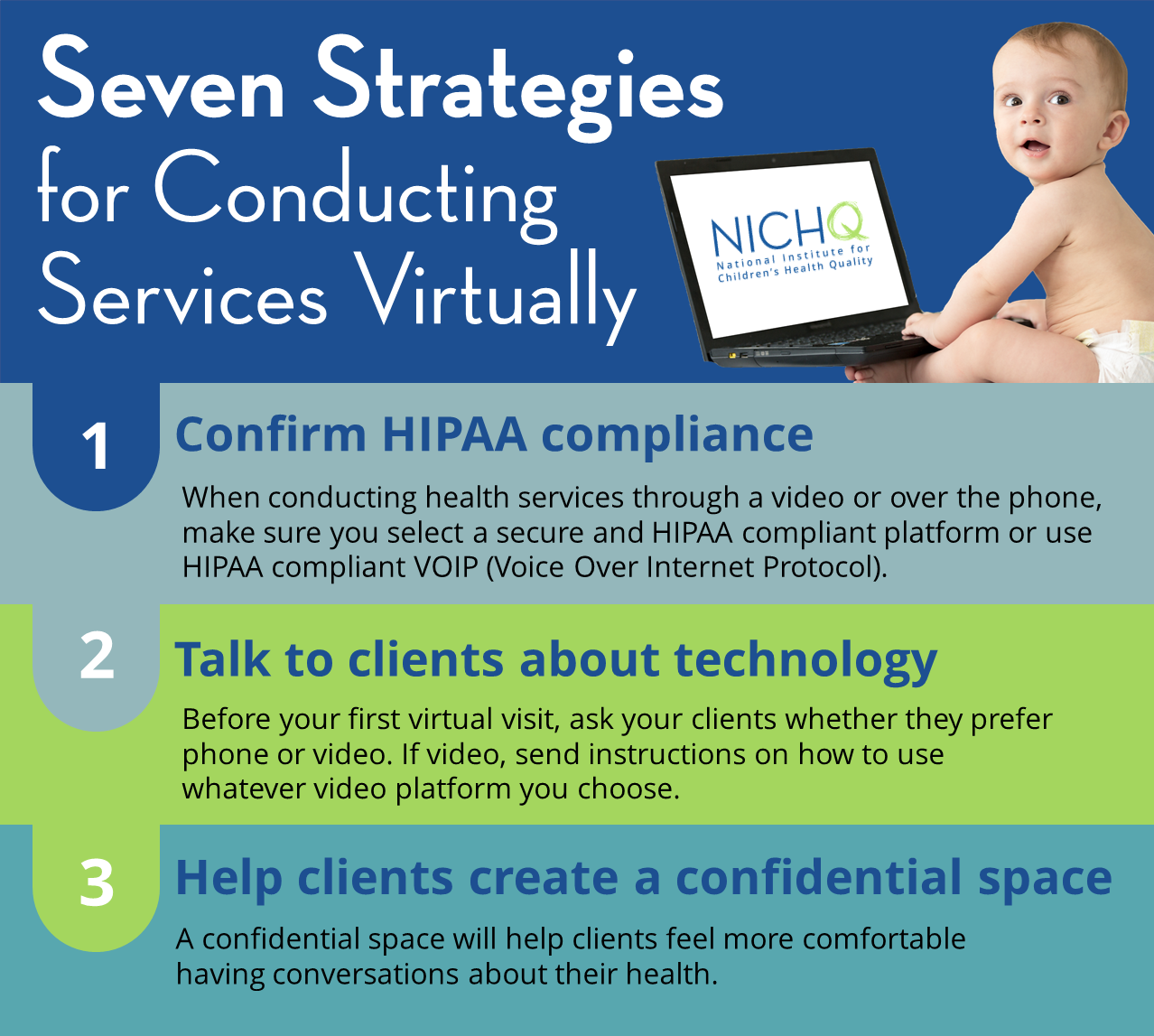Seven Strategies for Conducting Services Virtually
 Across the country, health and social service providers have had to find new ways to support children and families in the face of COVID-19. Home visiting services, pediatric well-child visits, prenatal care, and mental health appointments have largely had to transition from in-person appointments to visits virtually—either via phone or video. At the same time, COVID-19 has worsened and added to stressors that make these services even more necessary, namely increased anxiety, collective fear and grief, isolation, and financial hardship, and worse, COVID-19’s impact on those living with chronic conditions.
Across the country, health and social service providers have had to find new ways to support children and families in the face of COVID-19. Home visiting services, pediatric well-child visits, prenatal care, and mental health appointments have largely had to transition from in-person appointments to visits virtually—either via phone or video. At the same time, COVID-19 has worsened and added to stressors that make these services even more necessary, namely increased anxiety, collective fear and grief, isolation, and financial hardship, and worse, COVID-19’s impact on those living with chronic conditions.
By learning how to conduct a successful virtual visit, health and social service providers can help ensure children and families receive the support they need during and after this pandemic.
Importantly, according to licensed counselor Jana Glass, LPC, MAC, PMH-C, BC-TMH, care delivered virtually can be just as effective as face-to-face visits. “That is really good news right now; you just need certain conditions in place that model what you do in the office,” says Glass.

Identifying sustainable processes for supporting virtual services may have a big impact on families after COVID-19 has passed. They provide a needed alternative for families to receive care when other challenges – such as transportation or time – make it difficult for them to travel to prenatal and pediatric appointments.
Glass recently shared her significant experience conducting virtual services with the Supporting Healthy Start Performance Project (SHSPP), a national initiative where NICHQ serves as the Healthy Start Technical Assistance and Support Center and provides capacity building training and performance support to all Healthy Start programs. Below, we’ve compiled seven essential strategies from Glass’ presentation that health and social services providers can use to better support families virtually.
1. Confirm HIPAA compliancy
HIPAA compliance safeguards the privacy and security of protected health information. When conducting health services through a video platform, it’s important to make sure you select a secure and HIPAA compliant platform. This platform should provide end-to-end encryption and a signed Business Associate Agreement (BAA), both of which ensure that any personal health information shared on the platform will be kept secure and confidential. If conducting health services over the phone, be sure to use a HIPAA compliant VOIP (Voice Over Internet Protocol) service, which ensures confidentiality for information shared on the phone through an internet service. Consider using a separate cell phone that is exclusively for work purposes, so there is no risk of mixing up communications with your clients and your personal network. You can learn more about HIPAA compliance and telehealth here.
During COVID-19, the Office for Civil Rights (OCR) at the Department of Health and Human Services (HHS) has released specific guidelines for supporting telehealth during the pandemic that acknowledges that some technologies may not fully comply with the requirements of the HIPAA Rule.
2. Talk to clients about technology
Whether you conduct services over the phone or through video depends on what works best for your client. Before your first virtual visit, ask them what they prefer. If video, discuss whether they have a device that can support video—such as a laptop, tablet, or smartphone—and reliable internet or cellular options to keep the connection clear. (Remember, a clear phone call is better than a choppy video). Finally, be sure to send them clear instructions on how to use whatever video platform you choose.
Some families may not have a cell phone, or they may have limited minutes or no internet. Many states provide government-funded cell phones and cell service to families facing financial challenges. Your clients may also qualify for free internet during the pandemic; if so, and if they have a phone or computer, consider conducting phone calls over the internet using a free program like Google Voice.
3. Help clients create a confidential space
Whether they’re receiving prenatal care or mental health services, clients will feel most comfortable if they can have those conversations in a confidential space. This is difficult right now because shelter-in-place requirements mean that many families are home together. Glass recommends proactively talking to clients about ways to find privacy and encouraging out-of-the-box thinking. She’s had clients meet with her from their car, when sitting outside, or even from their closets. Clients can add another level of privacy by wearing headphones or turning on the fan so that the background noise mutes their voice. If your client is the primary care provider for young children, talk to them about ways to engage their children during sessions and be as flexible as possible with timing.
4. Conduct sessions from a comfortable, professional environment
It’s important to conduct sessions from a professional, confidential environment with minimal background noise where you can be fully present. This goes a long way towards helping clients feel comfortable and supported. Check that your space is well-lit and make sure family members know not to disturb you during sessions. Also, remember to dress the same as you would during an in-person visit because this consistency helps put clients at ease.
During video calls, set your screen at an angle so your clients can see your face directly. Looking at the webcam instead of at your screen will help you make direct eye contact with clients. Glass recommends adding a colored sticky below the webcam as a reminder, or shrink the video image and place it right below the webcam so your eyes naturally go there.
5. Practice makes perfect
“A huge factor in how telehealth is effective is how confident and competent you feel,” says Glass. If you’re new to telehealth, practice first. Spend time getting comfortable on whatever platform you use, so you won’t be worried about technology challenges when you’re face-to-face with a client. Practicing with friends or family members will also help you feel more natural on-screen so that you can bring your personable self to your sessions. As your comfort level increases, so too will your confidence and ability to be authentic—all of which make a big difference in helping you build rapport with your client.
6. Prioritize self-care
“Self-care is everything,” says Glass. “The more calm and grounded we feel, the more support we are able to give.” Yet practicing self-care isn’t easy during a pandemic: common strategies for destressing—like going to the gym or meeting up with friends for coffee—aren’t possible; spending all day in front of a laptop screen can be really draining; and always working from home makes unplugging at the end of the day difficult.
That’s why it’s important to find alternative ways to unwind, such as through an online workout class or a virtual happy hour. Blue-light blocking screens and glasses can help with screen-fatigue, as can building time into your schedule to take a quick walk or even just stand up and stretch. Glass also recommends setting designated work hours that you stick to since there’s no physical delineation between work and home.
7. Have a safety plan in place
Safety planning during COVID-19 means making sure you have a clear process for responding to clients who are in danger (e.g., they are considering self-harm, they are victims of domestic violence, there is child abuse in the home). This plan is especially critical during COVID-19 because social isolation and added stress can increase the risk of mental health problems and domestic violence, as well as exacerbate alcohol and drug misuse.
When making your safety plan, consider what resources exist in your community, while keeping in mind that sending clients to the emergency room during the pandemic is not an option. Instead, make connections and plans with both the police and the closest mental health facilities to learn about alternatives to starting in a hospital emergency room. Also, try to establish an emergency contact; this way, if your client doesn’t join a call, you can check to make sure they are okay. Glass also suggests establishing a codeword or phrase with clients you know may be in danger, so they can subtly let you know if the person threatening them is listening to the session. By working with your client and proactively connecting with your community resources, you can ensure your client’s safety.
Looking for more ways to better support children and families during the COVID-19 pandemic? Learn how Baltimore Healthy Start is overcoming barriers to provide needed services and strengthen the communities they serve.
